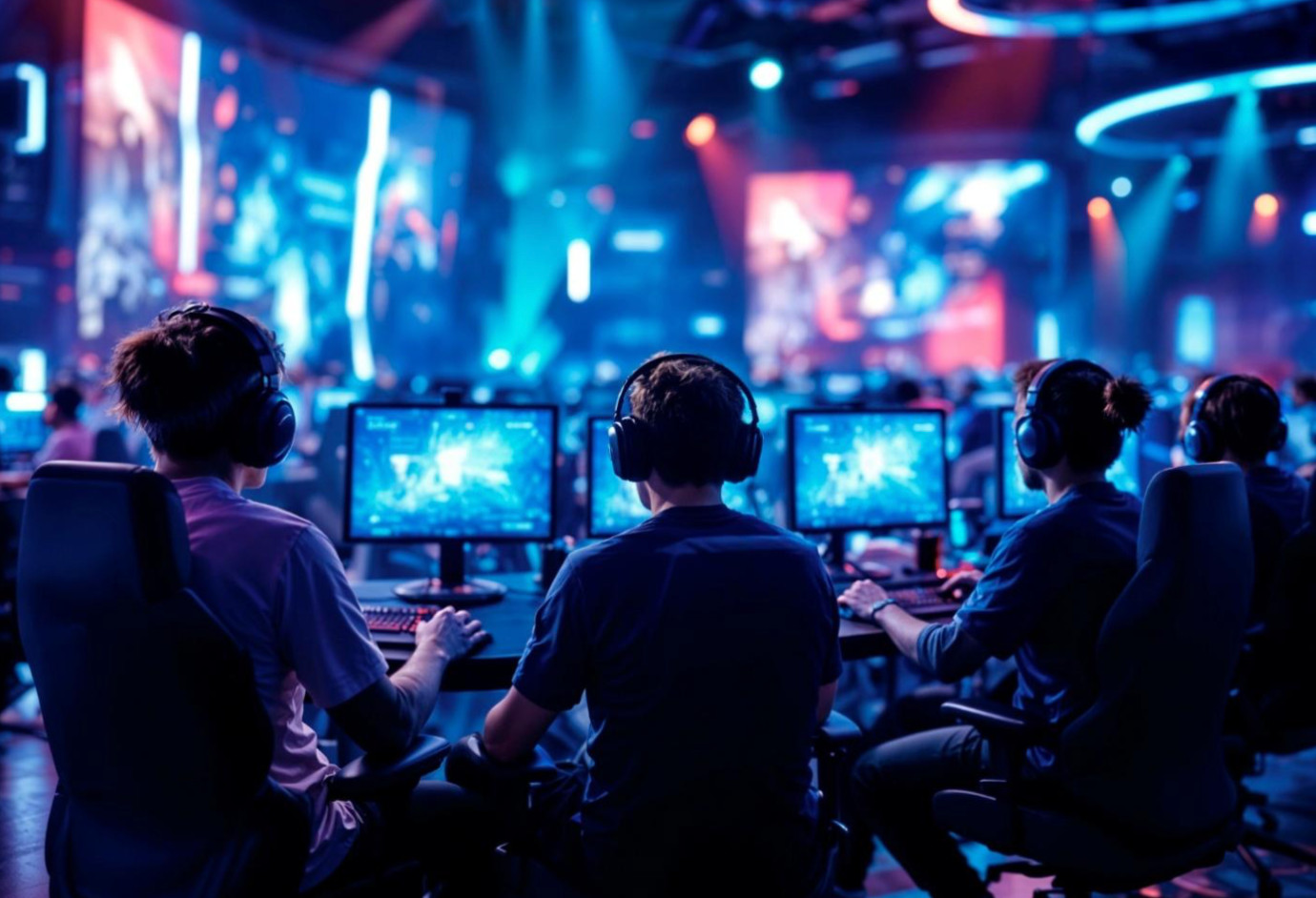Revenue Streams in eSports: How Do eSports Teams Make Money?
Contents
- Revenue Streams in eSports: How Do eSports Teams Make Money?
- Business Models in eSports
- Sponsorships and Brand Partnerships
- Broadcasting and Media Rights
- Merchandise and Ticket Sales
- Prize Money and Crowdfunding
- Naming Rights
- Subscriptions
- Royalties and Fees for Game Publishers
- New Trends and Prospects for eSports Teams’ Incomes
- In-Game Digital Purchases: One of the Main Sources of Income for eSports Teams in the Near Future
- Pros and Cons of eSports Sponsorships
- Final Words
- Frequently Asked Questions
Recomended bookmakers
KEY TAKEAWAYS:
- The majority of eSports’ income comes from sponsorships and advertising.
- In eSports, prize money usually goes to the individual competitors rather than the teams.
- The next standard for eSports revenue distribution will be a move away from sponsorship and toward in-game digital purchases.

Photo: Competitors in an eSports tournament (source: https://www.freepik.com/free-ai-image/esports-tournament_415577534.htm#fromView=search&page=1&position=2&uuid=e8c81cef-2ed6-47b2-8f17-49049daf4f39&query=esports)
As everyone is aware, eSports isn’t simply a thing of the future; we’re already living in its heyday. Globally, this marvel is becoming more and more prevalent. Companies are actively supporting events, more and more people are tuning in, and a wide range of people are enjoying competitive gaming.
A market research report published in October 2024 by Meticulous Research projects that the eSports industry will grow at a compound annual growth rate (CAGR) of 21.8% from 2024 to 2031, reaching $9.1 billion.
There are numerous opportunities for eSports teams, as well as stakeholders, to earn a substantial income due to the current surge in popularity of professional gaming. The many strategies they’re using to capitalize on this expanding market are examined in greater detail in this article.
So, how do eSports teams make money?
Business Models in eSports
Subscriptions, sales of merchandise, sponsorships, and broadcast revenue are just a few of the ways an eSports team might generate its income. Below is a breakdown of the revenue sources.
Sponsorships and Brand Partnerships
The majority of eSports’ income comes from sponsorships and advertising. According to Newzoo, 74% of eSports teams’ revenue came from this kind of revenue as early as 2017. Nowadays, approximately 95% of eSports teams’ current revenue is thought to come directly from sponsorship agreements. Many well-known sponsors have been drawn to eSports because of its market freshness, but teams have had difficulty turning sponsorships into a steady source of income. Popular games’ comparatively brief lifespan makes it difficult to maintain sponsorship. Even though a certain game is really popular right now, it may lose its appeal after, say, a year.
Since gaming gear and accessories are frequently on show during events, sponsorships pertaining to IT and computers are the most prevalent in the eSports sector. For instance, Activision Blizzard’s Overwatch League was sponsored by HP and Intel from day one, but no longer. The deal stipulates that rivals will only utilize HP’s OMEN gaming PCs and monitors. However, the teams don’t profit from that. They, however, do so thanks to the following sponsorship-related stuff:
- Integration of brands: Companies collaborate with eSports teams and events to reach a younger, tech-savvy audience.
- Sponsorships on jerseys: Brands can showcase their logos and slogans on team jerseys.
- Placements of products: Product sponsorships and placements within games can generate a significant amount of revenue.
Consistent recurring revenue adds to a company’s worth from a valuation standpoint. Sponsorships can give eSports teams steady income over the long run.
Broadcasting and Media Rights
While broadcasters search for eSports programming that would appeal to their target audiences, eSports broadcasting on television is still in its infancy. Street Fighter V and Counter-Strike: Global Offensive (before it became Counter-Strike 2) were shown on television thanks to a broadcasting agreement between TBS and ELeague, a US eSports content and live tournament brand. The ESPN, Disney, and ABC networks carried the Overwatch League when it first started. Most significantly, a broadcast TV arrangement didn’t nullify pre-existing distribution contracts, including Twitch broadcasts. But last year, the Overwatch League was shut down.
Currently, media rights and broadcasting help eSports teams make money in this way:
- Conventional broadcast agreements: Joining forces with well-known TV networks and sports channels can increase exposure and generate significant revenue.
- Platforms for streaming: Subscriptions, advertisements, and sponsorships are how Twitch, YouTube, and Facebook Gaming generate revenue.
- Creation of content: To attract spectators and generate revenue from advertisements, eSports teams produce content such as highlight reels, documentaries, and behind-the-scenes recordings.
It’s more challenging for eSports teams to obtain broadcast agreements than it is for game makers and league creators. Since such deals involve negotiations between game developers/league founders and the broadcasting corporations, eSports teams typically don’t receive a portion of the broadcast earnings.
Merchandise and Ticket Sales
Spending by consumers on eSports items is still quite minimal. Via their team websites, eSports teams sell clothing, accessories, and gaming gear. From the standpoint of valuation, sales of items may provide additional revenue. However, as the money is typically modest and one-time, apparel sales wouldn’t significantly affect an eSports team’s valuation.
A percentage of eSports’ revenue comes from ticket sales, just like any other in-person media experience. The current climate results in limits, even though some events have produced respectable numbers here. One could contend that the potential for ticket sales may genuinely exist online, given the digital nature of eSports. It might be profitable for organizers to charge more for spectators to see an improved or ad-free version of the events from the comfort of their homes.
- Live events: Large eSports competitions draw enormous throngs of spectators eager to get tickets and take in the action. The excitement brings in a sizable sum of money from ticket sales.
- Products: Collectibles, hats, and jerseys are examples of team merchandise that can generate a lot of revenue.
Prize Money and Crowdfunding
In eSports tournaments, prize money usually goes to the individual competitors rather than the teams. Even if the team doesn’t get paid, winning tournaments is a great way to build brand recognition. The prize pools for events have grown along with the eSports sector. The International 2018, the eighth annual Valve’s multiplayer online battle arena (MOBA) Dota 2 championship event, took place in Vancouver in August 2018, with the record for the highest single tournament prize pool in eSports history set: US$24.8 million total prize pool. The International 2020 was meant to break that record. Through player in-game purchases, US$40,018,195 was raised between May 22, 2020, and October 9, 2020. Players had to wait more than a year to have a chance to win some of the prize pool, which was supposed to be distributed at the event that was originally planned for August 18–23, 2020, in Stockholm, Sweden. However, the competition was postponed because of the COVID-19 pandemic. The International 2021 didn’t have that much money, though, in the prize pool as originally collected.
Approximately 94% of the $24.8 million prize pool for The International 2018 was crowdfunded, which is perhaps the most intriguing finding. Battle Passes, which offer event-exclusive features and benefits, were bought by regular Dota 2 players. The reward fund was increased by one-fourth of each Battle Pass.
- Prize pools: In order to increase the prize pools, tournament organizers frequently use crowdfunding, and they ultimately receive a lot of support from sponsors and fans.
- Bonuses and player salaries: With large salaries and bonuses, eSports players are making a lot of money, particularly in popular games like League of Legends and Dota 2.
Naming Rights
On March 7, 2018, Team Liquid formally launched a new training facility in Santa Monica, California. In addition to offering Team Liquid members a dedicated practice space, the building is home to 1UP Studios, the company’s content creation division. A departure from the current model is represented by the construction of a specific training facility. After investing more than $1.5 million in its construction, Team Liquid was able to sell the naming rights to the training center to the gaming PC company Alienware for $4.5 million, generating additional cash.
In general, it’s a relatively new tendency for eSports teams to own their training facilities. There will probably be an increase in the selling of facility naming rights as eSports continues to expand.
Subscriptions
Even though, in terms of prize money earned by eSports teams, Luminosity Gaming isn’t even close to the top, they have Tyler Blevins, popularly known as “Ninja”, who’s perhaps the most famous eSports streamer in the world. He recently disclosed that his more than 160,000 paying Twitch subscribers generate $500,000 a month. Twitch customers pay $5.00 a month, while streamers make $3.50 for every subscription. Ad-free streams and special badges are available to Twitch subscribers.
An eSports team’s visibility can be enhanced by having well-known players on the roster, which will eventually result in more fans and subscribers, making this another consistent source of income for a team.
Royalties and Fees for Game Publishers
- Fees for licensing: In order to use game publishers’ intellectual property, eSports organizations frequently pay them licensing fees.
- Sharing of revenue: To split the money made from viewing and merchandise sales, several groups work with game publishers.
New Trends and Prospects for eSports Teams’ Incomes
- Betting on eSports: With the legalization of sports betting in many countries, there are now plenty of chances to make money by forming alliances with bookmakers. The legality of betting activities in their different jurisdictions must be carefully checked by bettors. Serious repercussions may result from failing to fulfill this obligation while placing bets on an eSports betting site.
- Integration of NFTs and cryptocurrencies: Non-fungible tokens (NFTs) and cryptocurrency are revolutionizing the exchange of digital assets such as player cards and in-game merchandise.
- Augmented reality and virtual reality: Immersion technologies are transforming fan interaction by producing captivating and motivating virtual worlds. Imagine establishing unprecedented connections with your favorite teams and performers while creating innovative new opportunities for merchandise and income development.
- Training centers and eSports academies: Future champions will benefit from the increased demand for professional training and development programs as eSports becomes a more popular career option.
In-Game Digital Purchases: One of the Main Sources of Income for eSports Teams in the Near Future
According to industry insiders, the next standard for eSports revenue distribution will be a move away from sponsorship and toward in-game digital purchases.
Although eSports has made a significant effort to imitate the traditional sports industry’s business model, which involves splitting centralized income with teams, the economic slump that has harmed the sponsorship sector has necessitated adjustments.
A year ago, Riot Games, a leading publisher and developer of video games, announced plans to establish a League of Legends Global Revenue Pool (GRP). This GRP will gather money from digital content and distribute it to franchised teams according to a number of criteria, such as their fan base and competitive performance.
Teams will get a set stipend from Riot in addition to the GRP earnings. Although Riot stated that it would continue to give 50% of other direct earnings, like sponsorships and media rights, after it recoups its yearly investment in League of Legends eSports, the adjustments come at the expense of abandoning sponsorship revenue sharing.
Riot claimed to have drawn inspiration from Valorant’s economic model, which gives partner teams a cut of in-game item purchases, which totaled $33 million in 2023. Meanwhile, the sale of player autograph stickers and team logo stickers in rival company Valve’s Counter-Strike 2 has been incredibly popular. With the new paradigm, stakeholders have aligned financial motivations instead of vying for the same small pool of sponsorship funds.
Although some in the eSports sector view Riot’s action as groundbreaking, others think it acknowledges the necessity for game publishers and developers to support and reward the team organizations that participate in their titles. And it’s likely to be a model rival publishers and game developers adopt.
Pros and Cons of eSports Sponsorships
| PROS | CONS |
| The eSports audience is expanding quickly. | The possibility that marketing initiatives would be viewed as unwelcome or invasive. |
| A powerful tool for raising brand awareness. | Sponsoring a field that has been linked to violence, poorer grades, sexism, and betting scandals could potentially harm a sponsoring company’s reputation. |
| Increased sales are advantageous because eSports fans typically earn more than the ordinary person. | The potential for the sponsored party to perform poorly. |
| The audience for eSports has demonstrated that they typically comprehend the financial needs of sponsors. | Because of the unique “language” used by the eSports community, eSports advertising efforts differ greatly from traditional or social media advertising. |
| Sponsoring eSports is far less expensive than traditional sports because the eSports sector is still in its infancy. | An environment that’s unstable and volatile. |
Final Words
An exciting, fast-paced, and ever-evolving world is what the eSports sector is. Stakeholders can take advantage of the amazing prospects in this booming business by delving into its many revenue streams and monitoring new trends. With its increasing popularity, eSports is poised to become a major force in the world of entertainment, changing our perceptions of both competitive gaming and entertainment in general.






